Mount Fanjing, standing tall at over 100 meters above the surrounding landscape, beckons adventurers on a quest for both physical and spiritual elevation. This awe-inspiring peak, located in China’s Wuling Mountain range, invites visitors to embark on a remarkable journey, ascending nearly 9,000 steps to reach its summit. At the pinnacle, two magnificent Buddhist temples, the Temple of the Buddha and the Temple of Maitreya, await, connected by a delicate footbridge that adds a poetic touch to the spiritual journey.
The ascent of Mount Fanjing is no ordinary climb—it’s a pilgrimage of the soul. As visitors begin their climb, the world below gradually transforms into a panorama of emerald-green foliage, creating a sense of detachment from the mundane and a connection to the ethereal. Each step becomes a metaphor for the spiritual journey, symbolizing determination, perseverance, and the pursuit of higher realms.
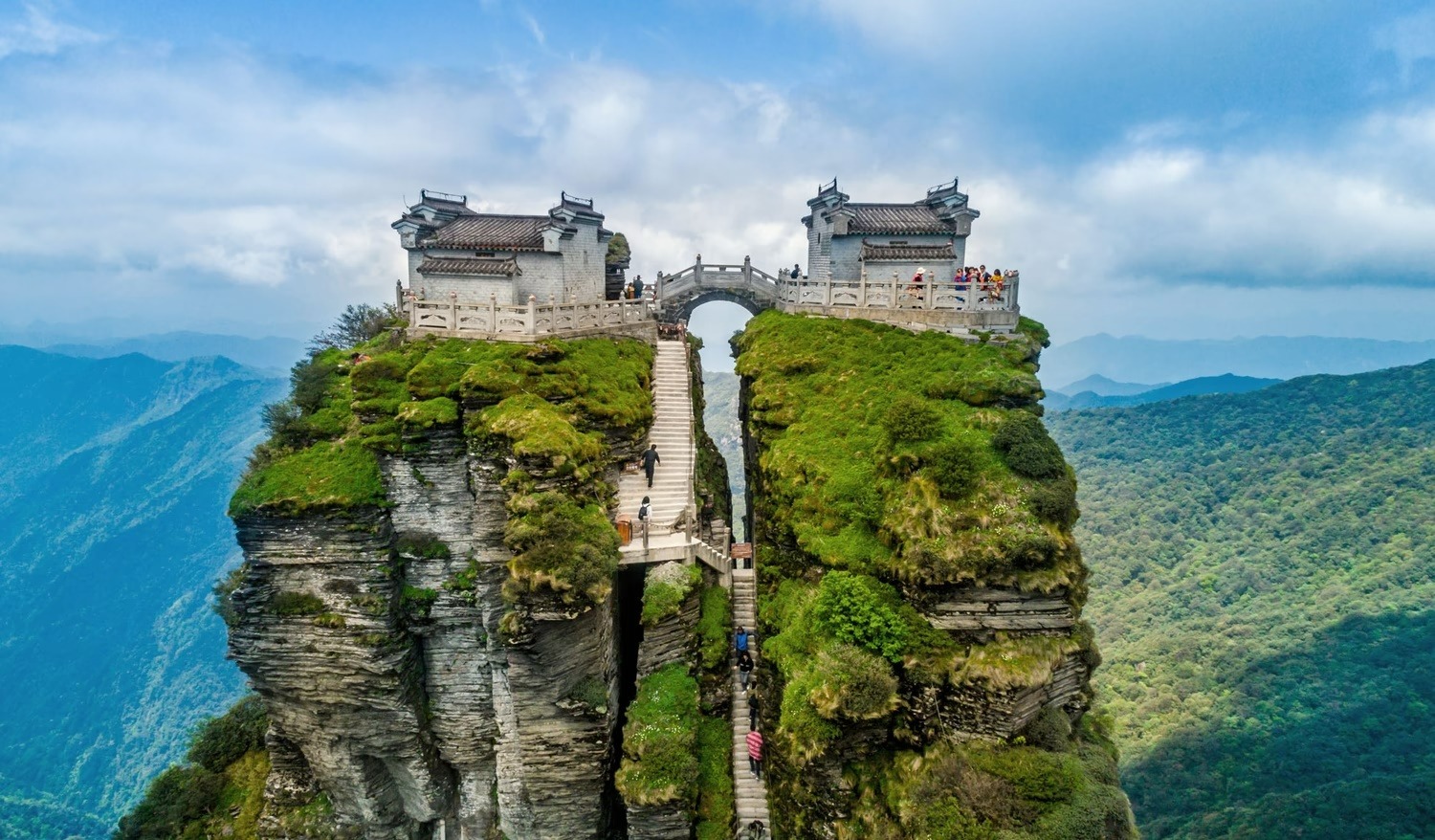
At the summit, a scene of divine beauty unfolds—the Temple of the Buddha and the Temple of Maitreya. These two Buddhist temples stand as serene guardians, overlooking the vast expanse below. The architecture, adorned with intricate details, reflects a harmonious blend of spiritual devotion and artistic expression. As the sun’s rays dance on the temples, a sense of tranquility envelopes the sacred space.
Mount Fanjing, steeped in religious significance, holds a deep connection to Buddhism. The temples at its summit serve as places of worship and contemplation, providing pilgrims and visitors alike with a sanctuary for spiritual reflection. The air is imbued with a sense of reverence, as if the mountain itself resonates with the prayers and aspirations of those who ascend its heights.

A small footbridge gracefully connects the Temple of the Buddha and the Temple of Maitreya. This slender pathway symbolizes the delicate balance between the spiritual and the earthly, inviting contemplation on the interconnectedness of all things. Crossing this bridge becomes a symbolic transition, traversing the space between the temporal and the divine.
The reward for the arduous ascent is not only found in the temples but also in the panoramic view that unfolds at the summit. The surrounding landscape stretches as far as the eye can see, revealing a breathtaking tapestry of mountains, valleys, and the ever-changing sky. It is a reminder that the spiritual journey is not only an internal exploration but also an appreciation of the vast beauty that surrounds us.
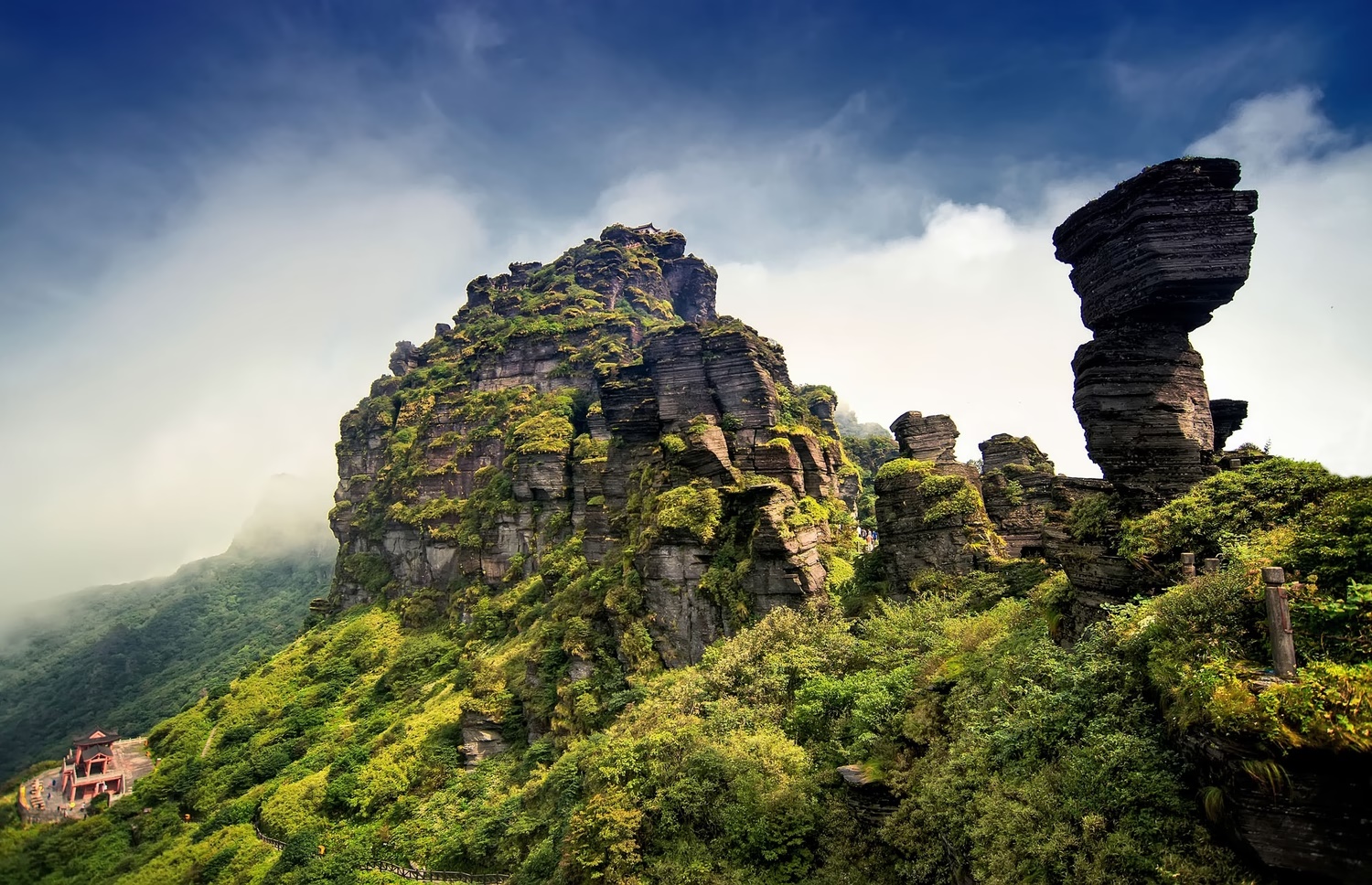
Mount Fanjing, with its towering stature and sacred temples, offers more than just a physical climb—it is a pilgrimage for the soul. As visitors ascend its steps, they embark on a journey of self-discovery, spiritual reflection, and communion with the divine. The temples at the summit, connected by a delicate footbridge, stand as testaments to the harmony that can be achieved when the earthly and the spiritual coalesce. In the embrace of Mount Fanjing, travelers find not only a peak on the physical map but also a pinnacle of spiritual ascent.
In the heart of China’s Wuling Mountain range, amidst the breathtaking landscape, lies Mount Fanjing—an oasis of serenity and spiritual resonance. Renowned as one of the world’s most isolated Buddhist monasteries, Mount Fanjing stands as a testament to the enduring connection between nature and spirituality.
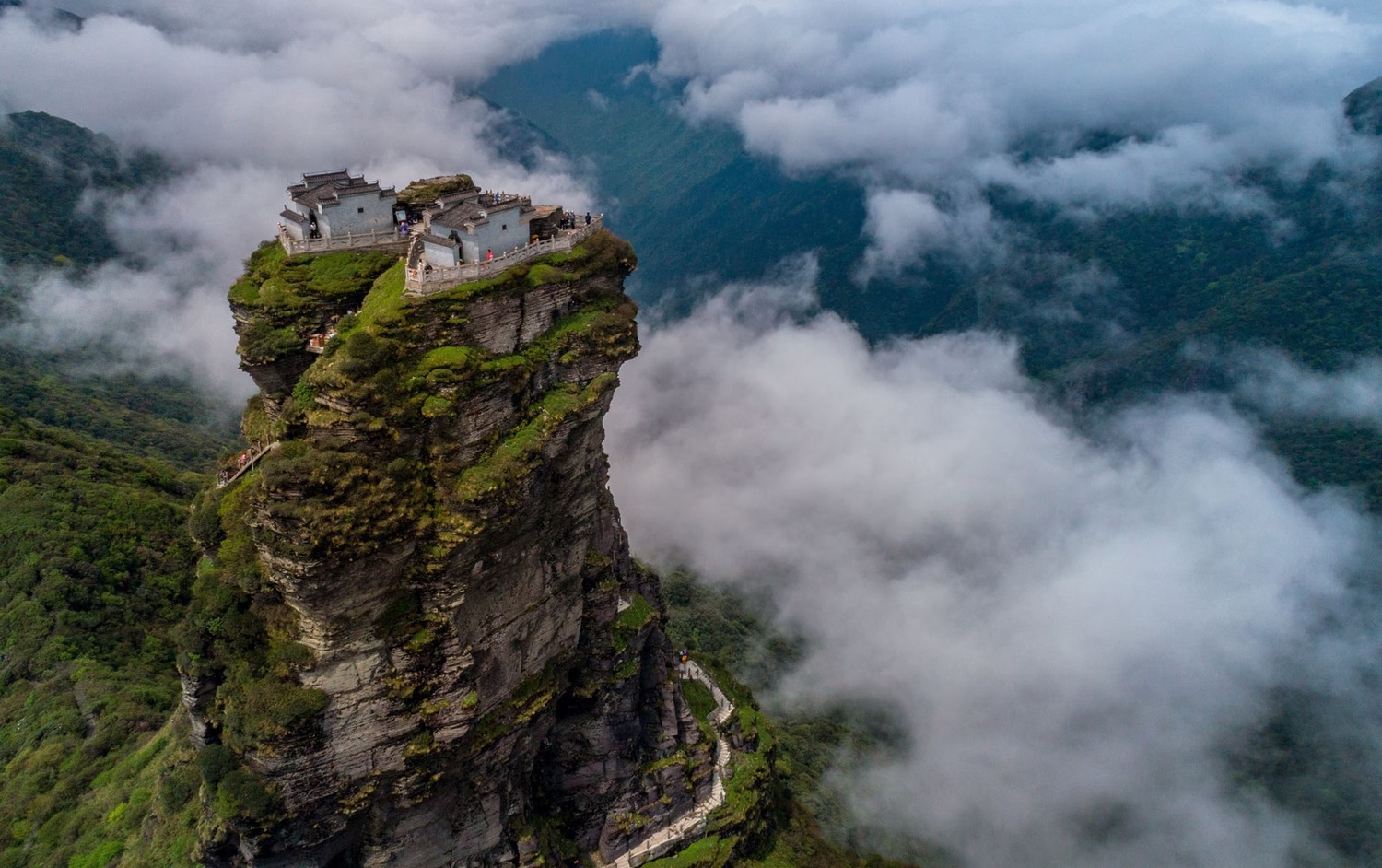
Mount Fanjing’s isolation is not only geographical but also an immersion into the natural grandeur that surrounds it. Nestled in mist-covered peaks and lush greenery, the monastery is a sanctuary of tranquility, offering a retreat from the hustle and bustle of the outside world. The isolation becomes a deliberate choice, fostering an environment conducive to introspection and devotion.
To reach Mount Fanjing is to embark on a pilgrimage of both physical and spiritual ascent. With its summit rising over 100 meters above the surrounding landscape, visitors undertake a journey of nearly 9,000 steps, symbolizing a metaphorical climb towards higher realms of consciousness. The arduous ascent itself becomes a transformative experience, reinforcing the spiritual connection with each step.

At the zenith of this spiritual mountain stands a testament to faith—the Temple of the Buddha and the Temple of Maitreya. Linked by a small footbridge, these temples are architectural marvels, echoing the rich traditions of Buddhism while harmonizing with the natural contours of Mount Fanjing. The monastic structures, adorned with intricate details, are not just places of worship but physical embodiments of spiritual devotion.
Mount Fanjing’s isolation has preserved a distinct form of Buddhism—one deeply connected to nature and influenced by the mountain’s unique energy. The monks who reside in this isolated sanctuary practice a form of Buddhism that reflects the simplicity of their surroundings. The mountain becomes not just a location for worship but an active participant in the spiritual journey of those who seek solace in its heights.

A small footbridge gracefully unites the two temples, symbolizing the delicate harmony between the spiritual and the earthly. As visitors traverse this slender pathway, they symbolically cross the space between the temporal and the divine. The footbridge serves as a reminder that, despite its isolation, Mount Fanjing is intricately woven into the fabric of existence, bridging worlds in both a physical and metaphysical sense.
Mount Fanjing’s isolation has become increasingly rare in our interconnected world. The preservation of this solitude is not only vital for the spiritual practices of the monks but also for the preservation of the mountain’s unique ecosystem. Efforts to maintain this delicate balance between isolation and interconnectedness are crucial for ensuring Mount Fanjing remains a haven for seekers of spiritual enlightenment.
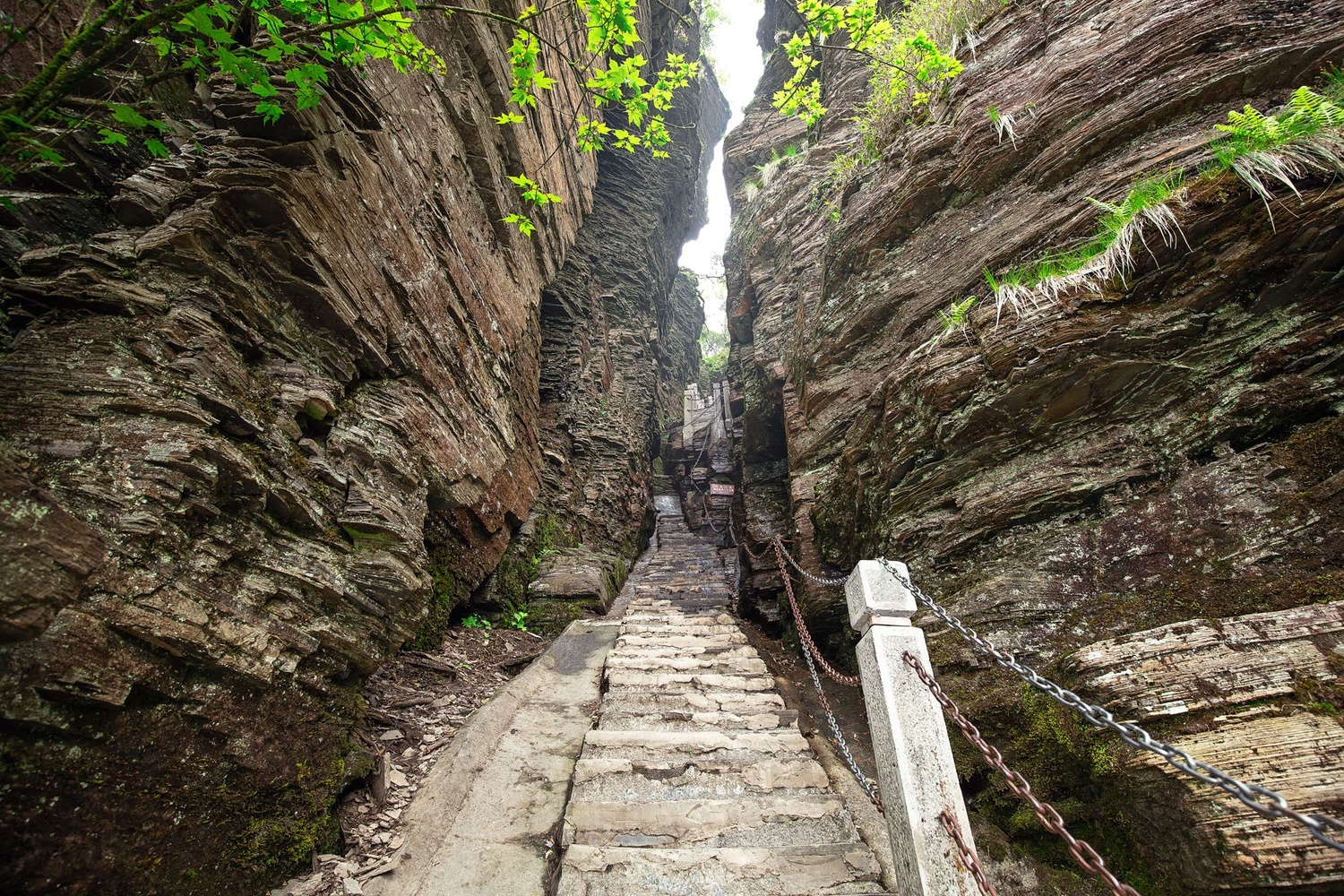
Mount Fanjing, with its isolated Buddhist monasteries and majestic peaks, stands as a beacon of spiritual serenity in a fast-paced world. Its isolation is not a barrier but a deliberate choice, creating an environment where nature and spirituality coalesce. As one of the world’s most isolated Buddhist monasteries, Mount Fanjing invites us to embark on a journey of self-discovery, to ascend its heights not only physically but also towards the spiritual peaks that echo with the wisdom of centuries. In the embrace of Mount Fanjing, isolation becomes a sacred space where the spirit finds solace and connection with the divine.
As the sun kisses the peaks of Mount Fanjing, revealing a spectacle of unparalleled beauty, the Temple of the Buddha and Maitreya Temple stand in silent reverence atop the New Golden Summit. This remarkable vantage point not only offers a breathtaking view of the surrounding landscape but also unveils the architectural marvels that are the spiritual heart of Mount Fanjing.
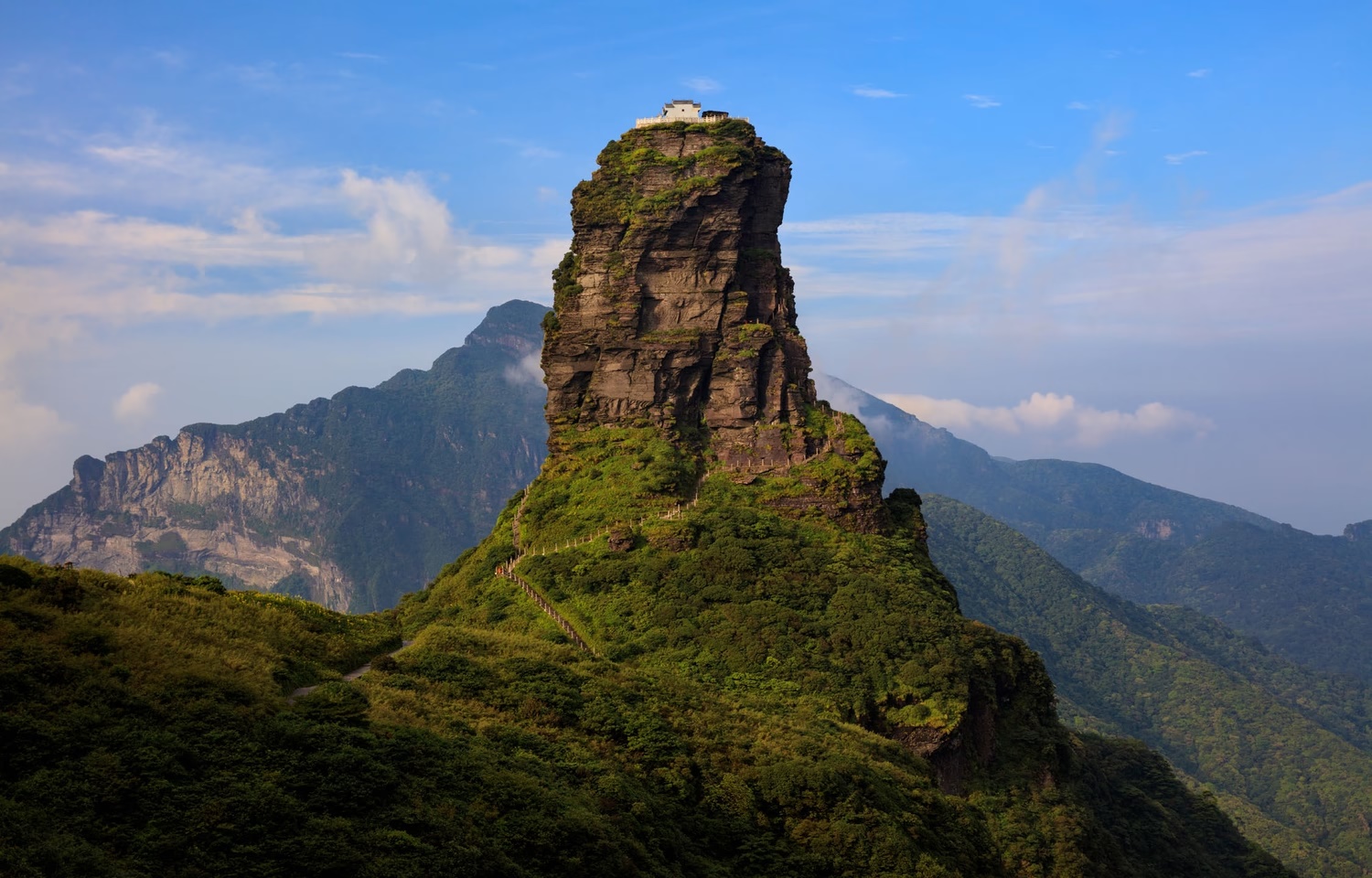
Captured from an aerial perspective, the Temple of the Buddha and Maitreya Temple present a sight that transcends the earthly realm. Perched like guardian deities at the summit, these two Buddhist temples command attention with their intricate design, vibrant colors, and an aura of spiritual sanctity. The angle from above allows for a unique appreciation of the temples’ layout, revealing the symbiotic relationship they share with the mountainous terrain.
The architectural prowess of the Temple of the Buddha and Maitreya Temple is evident from the aerial view. Intricately carved facades, golden embellishments, and the meticulous layout create a visual symphony that harmonizes with the natural contours of Mount Fanjing. The temples, seemingly an extension of the mountain itself, embody the seamless integration of spiritual devotion and artistic expression.

Atop the New Golden Summit, the Temple of the Buddha and Maitreya Temple serve as spiritual oases, inviting pilgrims and visitors to experience a profound connection with the divine. The aerial perspective reveals the thoughtful placement of these sanctuaries, surrounded by the unspoiled beauty of the mountain. The temples become not only places of worship but also gateways to a transcendent realm.
The New Golden Summit serves as a majestic backdrop to the temples, bathed in the golden hues of the rising or setting sun. From above, the intricate details of the temples’ rooftops, adorned with traditional Chinese architectural elements, become apparent. The golden glow reflects the reverence bestowed upon this sacred space, echoing the spiritual significance it holds for those who ascend to its heights.
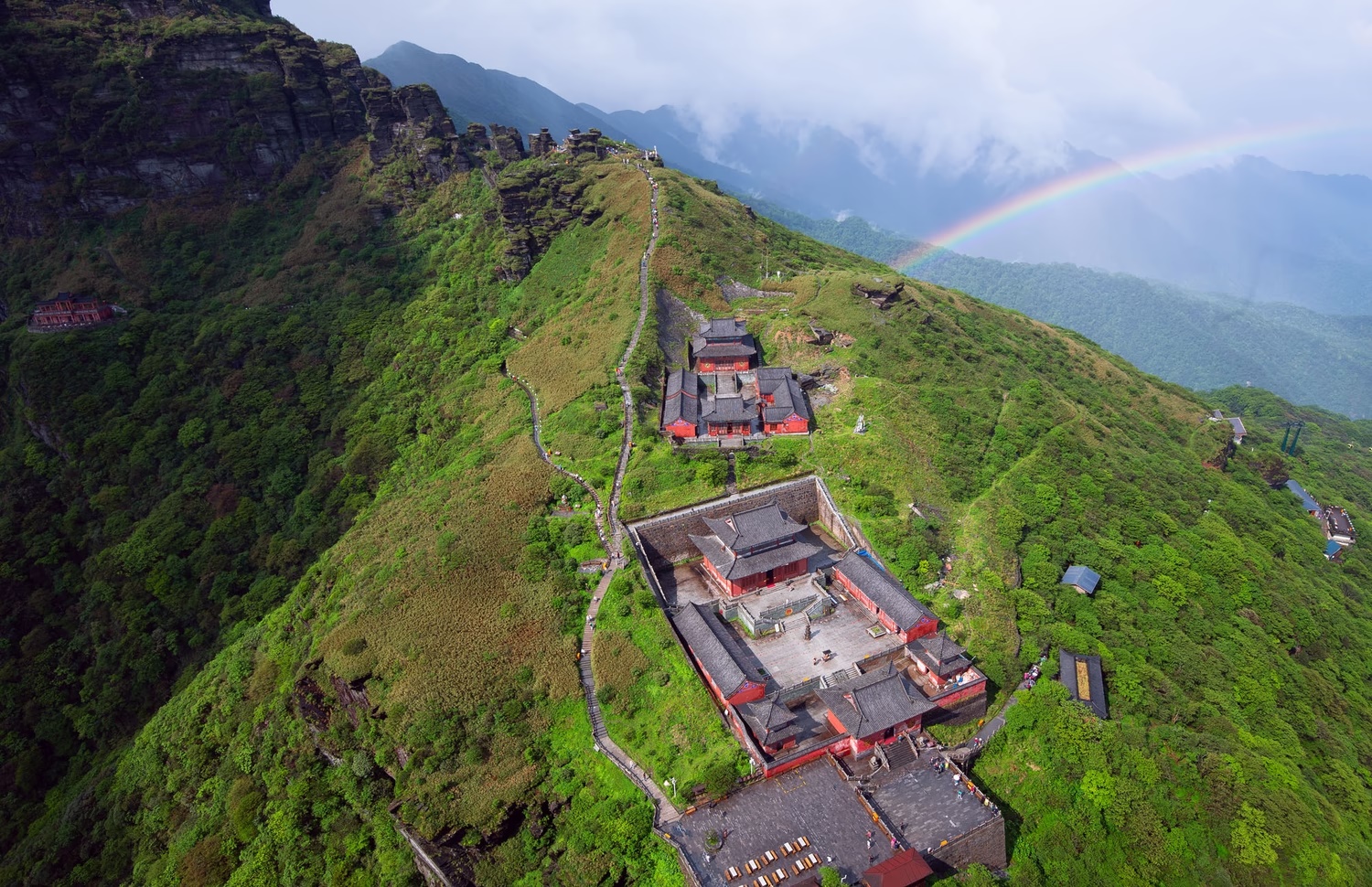
The aerial perspective captures the symbolic connection between the Temple of the Buddha and Maitreya Temple. Linked by pathways and surrounded by the natural grandeur of Mount Fanjing, these sacred sites form a holistic representation of the pilgrimage journey—a journey that transcends physical steps and ascends into the realms of spiritual enlightenment.
In the rarefied air of Mount Fanjing’s New Golden Summit, the Temple of the Buddha and Maitreya Temple emerge as beacons of spiritual enlightenment and architectural grace. The aerial view not only magnifies the temples’ physical beauty but also captures the profound connection they share with the mountainous landscape. As we gaze upon these sanctuaries from above, we are invited to contemplate the union of the earthly and the divine—a testament to the timeless allure of Mount Fanjing’s spiritual legacy.

Perched majestically on the New Golden Summit, the connecting bridge between the sacred temples offers a mesmerizing aerial spectacle, elevating the spiritual journey to new heights. This short yet significant bridge serves as a symbolic link, not only physically connecting two temples but also bridging the earthly realm with the divine. Let’s embark on a virtual journey, soaring above the breathtaking landscape to witness the serene beauty of this aerial view.
As the aerial view unfolds, the New Golden Summit reveals itself as a tranquil haven, cradling the temples in its embrace. The lush greenery surrounding the temples forms a serene backdrop, accentuating the spiritual significance of the structures. The short bridge, delicately connecting the Temple of the Buddha and the Temple of Maitreya, becomes a focal point, suspended in mid-air like a celestial thread weaving through the heavens.
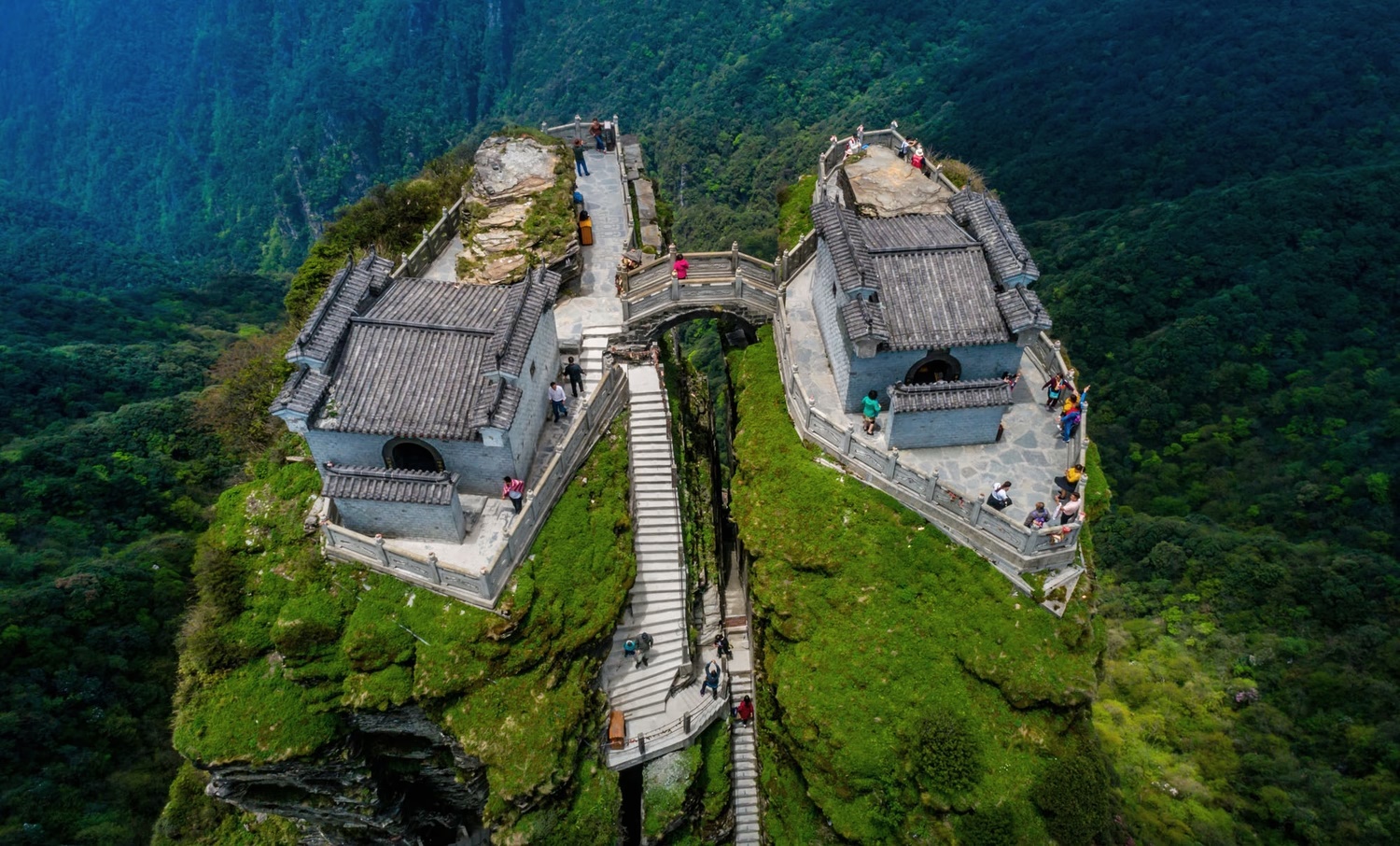
From above, the bridge appears as a harmonious architectural masterpiece, seamlessly blending with the natural contours of the landscape. Its design mirrors the essence of simplicity, allowing the temples to stand out against the verdant canvas. The bridge’s modest length serves not only as a physical connector but also as a metaphorical passage, inviting pilgrims to traverse the threshold between the sacred and the terrestrial.
The aerial perspective unveils the meticulous symmetry of the bridge, framing a picturesque scene of spiritual sanctity. The slight curvature of the bridge enhances its aesthetic appeal, creating a sense of fluidity and grace. From this vantage point, the architectural details of the temples become intricate brushstrokes on the canvas of the mountainous terrain.
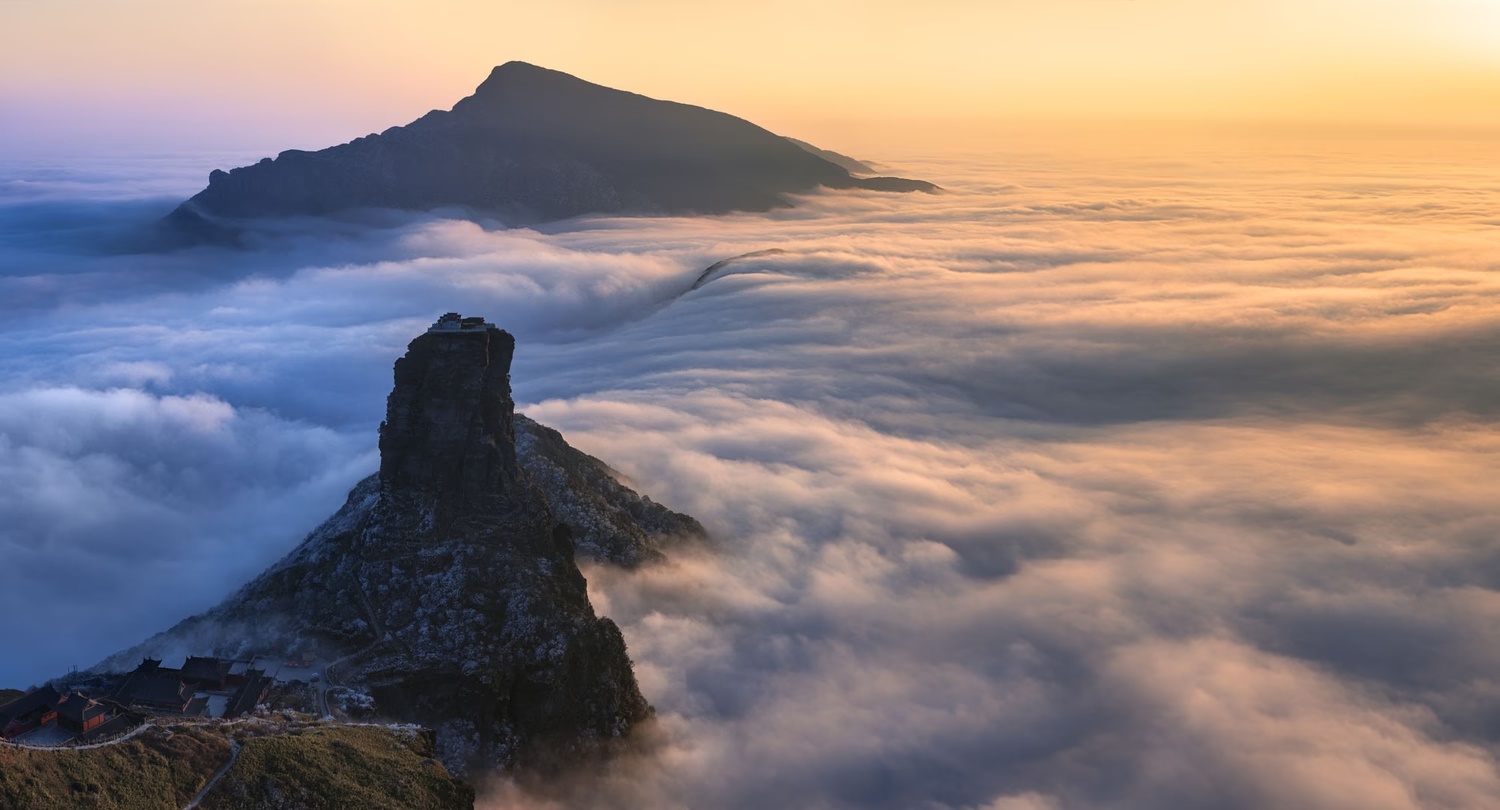
As the aerial view captures the expanse between the two temples, it encapsulates the essence of the spiritual journey. The bridge represents a conduit for contemplation, urging visitors to traverse the physical gap while reflecting on the metaphysical connection between the earthly and the divine. The temples, bathed in the glow of aerial light, beckon the soul to embark on a transcendent pilgrimage.
The aerial perspective allows us to appreciate not only the architectural significance of the bridge but also the serene surroundings. The mountainous landscape unfolds in gentle undulations, offering a visual symphony that harmonizes with the spiritual resonance of the temples. The aerial vantage point becomes a portal to tranquility, inviting contemplation and connection with the sacred.

In the ethereal dance between sky and earth, the aerial view of the short bridge connecting the temples atop the New Golden Summit unfolds as a visual poem. This celestial thread, suspended in mid-air, transcends the physical realm, inviting all who behold it to embark on a spiritual odyssey. The bridge, in its simplicity and elegance, becomes a symbolic gateway to enlightenment, fostering a connection between the terrestrial and the divine.
Mount Fanjing, a sacred peak rising majestically above the Wuling Mountain range, is not only a physical landmark but a spiritual sanctuary where the ethereal and earthly realms converge. Capturing the elusive moment when a rainbow graces the Buddhist temples atop Mount Fanjing becomes a profound endaor—an attempt to immortalize the ephemeral and portray a glimpse of divine harmony. These photographs go beyond mere visuals; they serve as portals into a spiritual experience, offering a testament to the transcendent beauty found within this sacred space.
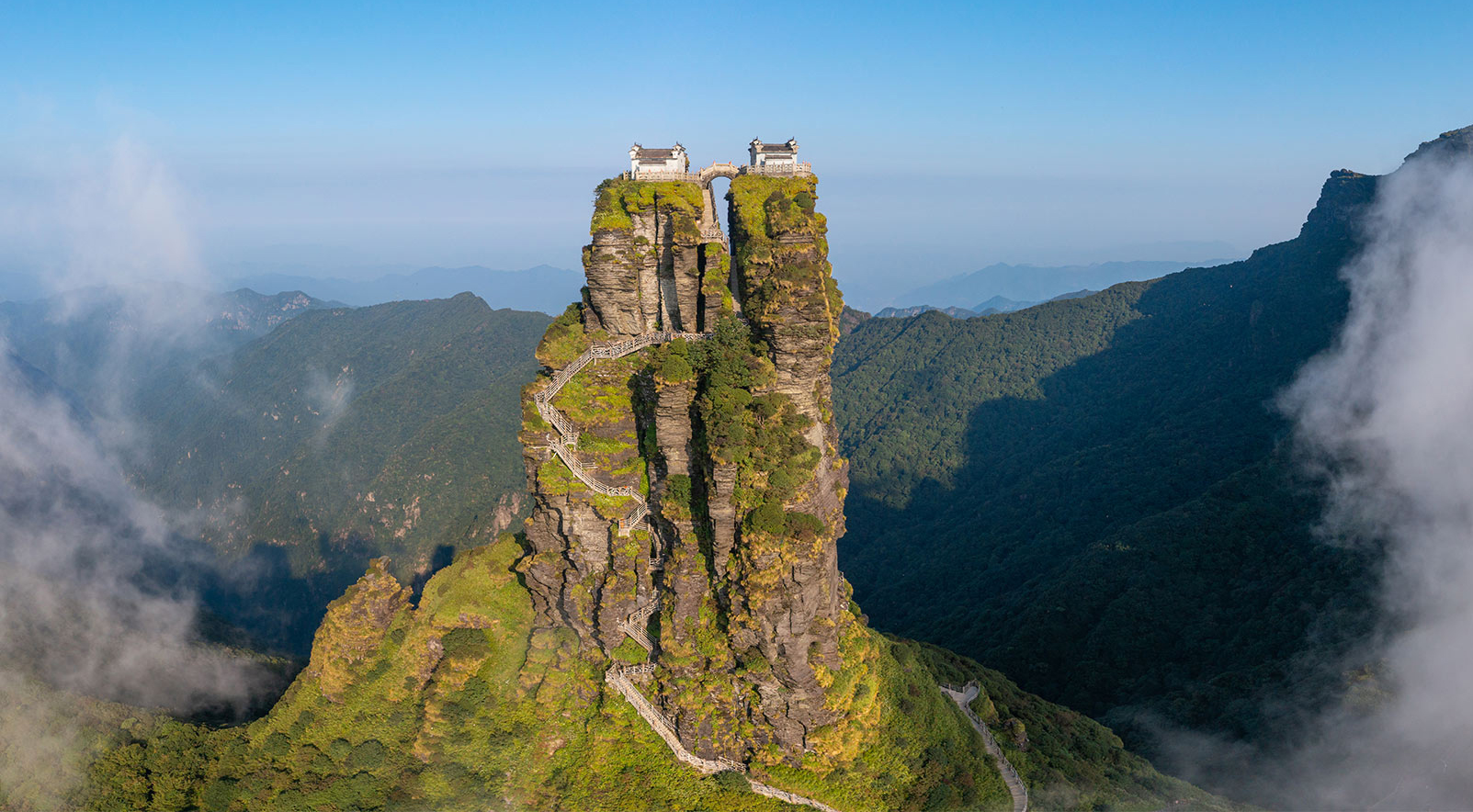
As sunlight interplays with moisture-laden air, a rainbow emerges, casting its ethereal glow upon the Buddhist temples at the summit of Mount Fanjing. This natural phenomenon becomes a celestial embrace—a moment when the heavens seem to smile upon the sacred structures. The vibrant hues of the rainbow juxtaposed against the serene backdrop of the temples create a scene that transcends the ordinary, offering a visual symphony of spiritual significance.




